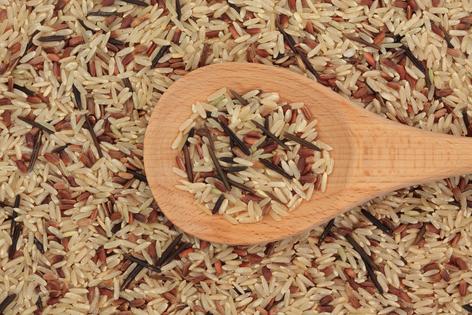Environmental Nutrition: Wild for wild rice
A great alternative to rice, wild rice has more protein than most other whole grains and is a good source of nutrients like fiber, B vitamins, and magnesium.
The folklore
Wild rice looks like rice and is eaten like rice, but this crunchy, chewy whole grain is actually an aquatic grass that grows wild in lakes and rivers mainly in North America. Considered an ancient grain, wild rice, native to the upper Great Lakes in the U.S. and Canada, dates as far back as 12,000 years ago.
The facts
There are four main varieties of wild rice, but the most common are Zizania aquatica and Zizania palustris. Unrelated to rice, wild rice is the grain of a reed-like aquatic grass with grains that are long, thin, and light brown to black. One half-cup serving of wild rice packs 11% DV (DV=Daily Value, based on 2,000 calories/day) of dietary fiber which helps keep you feeling satisfied and 14% DV of protein. Wild rice is also rich in antioxidant and anti-inflammatory plant compounds.
The findings
Compared to white rice, wild rice has more protein, less fat, higher B vitamin content, and is not refined, (i.e., it retains its germ and bran and all nutritive compounds, such as fiber, which are associated with reduced risk of chronic diseases such as obesity, Type 2 diabetes, cardiovascular disease, and some cancers. According to one review of studies (Food Chemistry, 2020), the phytochemical content of wild rice warrants its development as a functional food. These phytochemicals have antioxidant properties associated with the prevention of chronic diseases and may exert anti-inflammatory, antiallergic, and antihypertensive effects. Emerging evidence suggests wild rice may potentially help reduce insulin resistance and atherosclerosis.
The finer points
Due to its texture and density, wild rice takes longer to cook than other rice. Use a ratio of wild rice to water or broth of about one to three. Once it boils, reduce heat and allow rice to simmer about 35 to 50 minutes. When done, the grains will burst, but test for your preference of tenderness. One cup dried makes three to four cups cooked. Uncooked wild rice will store indefinitely in a dry container. Store cooked rice up to a week in the refrigerator and up to six months in the freezer. Combine wild rice with sauteed onion, garlic, herbs and spices for a simple pilaf, to coat fish, add to soups and salads and even pancakes and baked goods for a delicious, nutty crunch.
(Environmental Nutrition is the award-winning independent newsletter written by nutrition experts dedicated to providing readers up-to-date, accurate information about health and nutrition in clear, concise English. For more information, visit www.environmentalnutrition.com.)
©2024 Belvoir Media Group, LLC. Distributed by Tribune Content Agency, LLC.











Comments